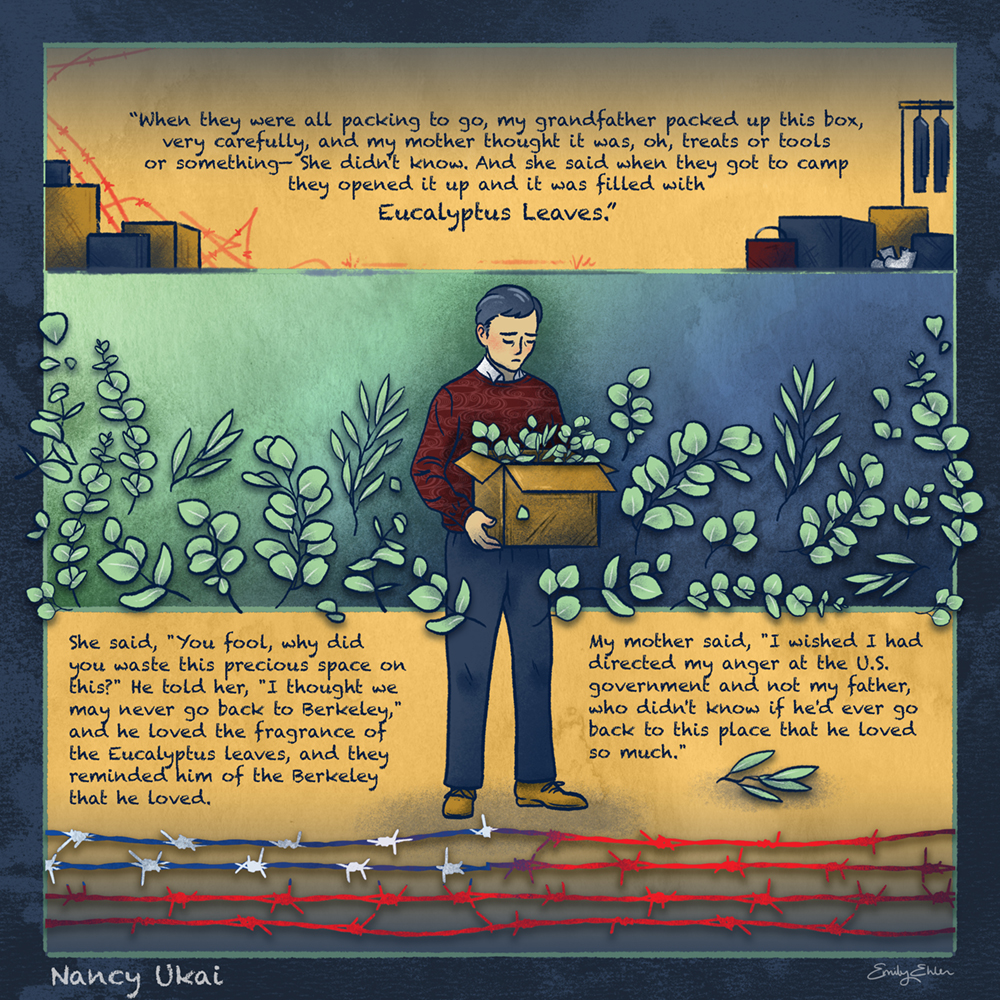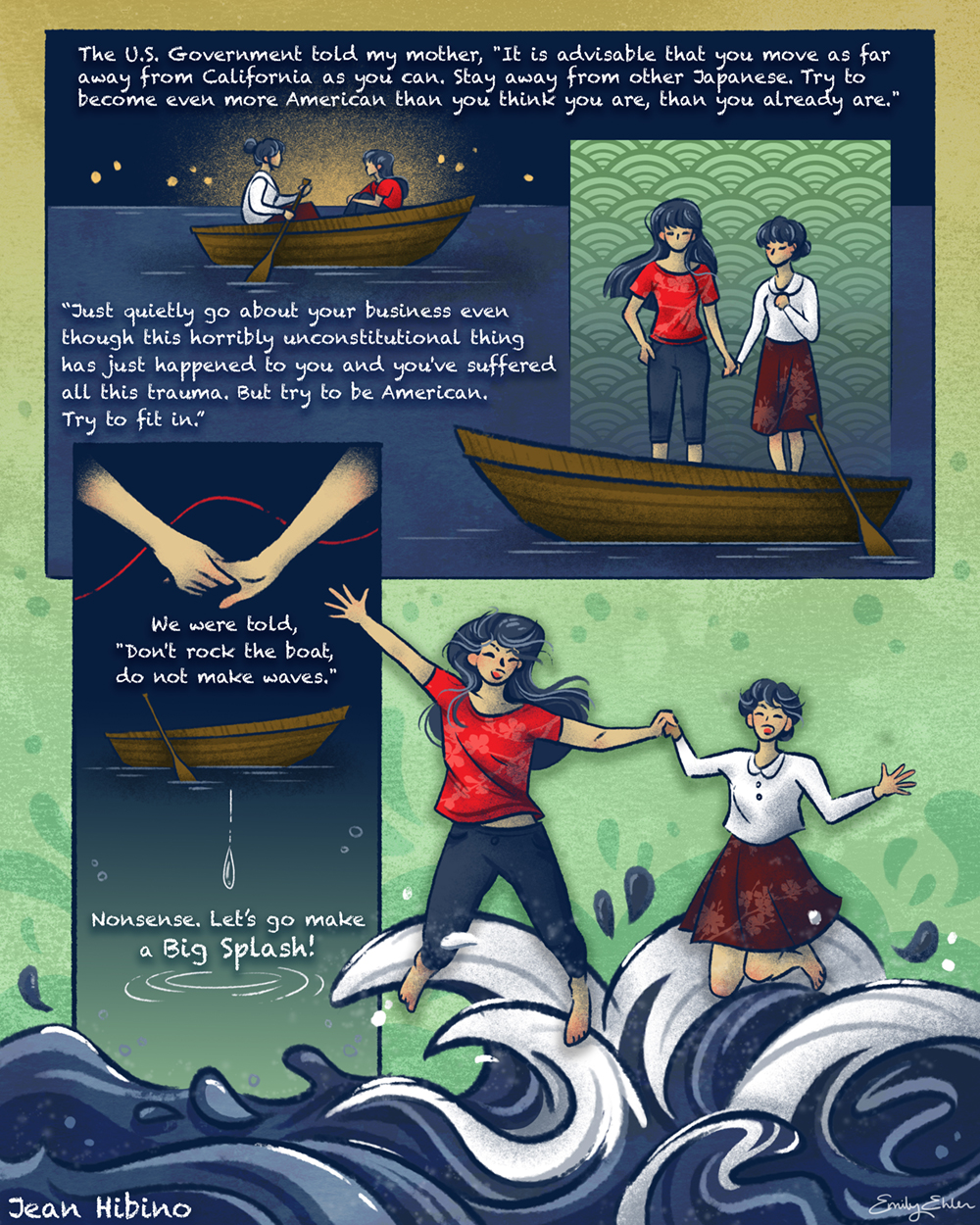
If you were forced to leave your home on short notice, carrying only the possessions that mattered most, what would you take?
Nancy Ukai’s grandfather, a Japanese American living in Berkeley during World War II, took something he feared he might never experience again — the scent of home. He packed eucalyptus leaves into a box, bringing a reminder of his beloved city to the incarceration camp where he was held.
That story is one of many moving testimonials collected in the recently launched Japanese American Intergenerational Narratives project, from The Bancroft Library’s Oral History Center, or OHC. The project documents the experiences of Japanese American child survivors and descendants of survivors of U.S. government-run incarceration camps at Manzanar, California, and Topaz, Utah. Through more than 100 hours of interviews with 23 narrators, the project explores the impacts of trauma across generations, and the potential for healing.
To complement the oral histories, the project team — co-led by Shanna Farrell, Roger Eardley-Pryor, and Amanda Tewes — commissioned a series of 10 illustrations. The gorgeous graphic novel-style images from artist Emily Ehlen serve as visual companions and illuminate the project’s overarching themes.
For Tewes, the drawings offer a unique entry point into a rich collection of testimonials. “We were thinking about ways that we could share these stories … with people beyond those who might just be interested in oral history,” she said. “How can you attract attention and gain ears and eyes? And the graphic art seemed like a really creative way to do that.”

Tewes and her colleagues knew from the outset that illustrations would be part of the two-year project, which began in 2021 with funding from a National Park Service Japanese American Confinement Sites Grant.
Eardley-Pryor, who originally suggested including a visual component, said one of several inspirations was the graphic novel Displacement, by Kiku Hughes, which grapples with similar stories. Incorporating artwork was especially fitting, Eardley-Pryor added, because some of the survivors and their descendants have turned to art as a way to process trauma.
All the team needed was an artistic collaborator. They found one in Ehlen, a Florida-based illustrator who had recently created a three-page comic about the Japanese American artist Kay Sekimachi, including Kay’s experience of incarceration during WWII, for the Smithsonian American Art Museum.
Ehlen carefully read the transcripts of the oral histories, immersing herself in the unique perspective of each narrator and noting any experience or memory that might be visualized. She was particularly pulled toward moments that evoked a strong response.
“The piece I got the most emotional while drawing was Nancy Ukai’s grandfather in Eucalyptus,” she said. “I sympathized with the longing and sadness of missing Berkeley that her grandfather felt. … It was heartbreaking to read, so I knew I had to draw it.”

In another drawing, titled Tree, Ehlen depicts three women of different generations holding hands in front of a towering tree. The trunk is wrapped in barbed wire, while the branches blossom with white paper cranes, calling to mind traditional Japanese origami.
The illustration draws from the oral history of descendant Jennifer Mariko Neuwalder, whose family was incarcerated at Topaz. She did origami as a child, and said it was important for her in connecting with her Japanese heritage. She also used origami in her career.
“When I was first starting to work as a child and adolescent psychiatrist, I thought about writing a paper about origami as metaphor, because the kids I would see would have a lot of trauma,” she said in her oral history. “And I liked the idea of a piece of paper, let’s say you crumple a piece of paper, you can still flatten it out, you can use it to make something beautiful, but you can’t undo those folds, you’ll still see evidence.”
Selections from Neuwalder’s oral history are featured in an accompanying podcast series produced by the OHC project team called ‘From Generation to Generation’: The Legacy of Japanese American Incarceration. The interpretive four-episode series is another doorway into the oral histories.
Healing is a theme that clearly emerges in Tree, as it does in many of the illustrations. The theme was central to the project, with the team’s original conceit being to answer the question: Is healing possible?
“The descendants have all sorts of different feelings about healing,” Eardley-Pryor said. “Some were like, that word doesn’t really resonate with me. And others were like, absolutely, this is all about healing.”

Activism is another theme that reverberates across many of the interviews. The idea is brought to life in the illustration Splash, which was inspired by the testimony of descendant Jean Hibino. The drawing depicts two women in a boat, visualizing a phrase Hibino’s mother was told by the U.S. government: “Don’t rock the boat, do not make waves.” The final panel culminates with the two women leaping into the water together to “make a splash.”
After her incarceration, Hibino’s mother worked in civil rights, which motivated Hibino to become an activist in the Bay Area. Later, Hibino’s activism inspired her mom to get involved in the Japanese American community to work toward redress for the family’s unjust incarceration.
The Japanese American Intergenerational Narratives project team is pleased by how well the work has been received. Farrell said she has gotten good feedback from the narrators, some of whom have asked to help promote the project or use Ehlen’s images.
The team plans to continue that important work. A recent grant from the Takahashi Family Foundation will allow them to turn their attention to descendants from the Tule Lake and Heart Mountain incarceration camps. Farrell and her colleagues would also like to train people within the Japanese American community to capture one another’s stories. The ultimate goal, of course, remains the same — to give voice to history that should not be forgotten.
“The reality is that 120,000 people were forcibly removed from their homes and put into prison camps for no other reason than their race and heritage,” Farrell said in a recent Q&A with Berkeley News. “It uprooted and devastated a lot of different communities, and that legacy continues today. And I think if we ignore the experiences of descendants, we’re actually ignoring history, because it does continue; it’s not a static thing. And it’s important to think about the ripples of this today, so we don’t repeat them in the future.”